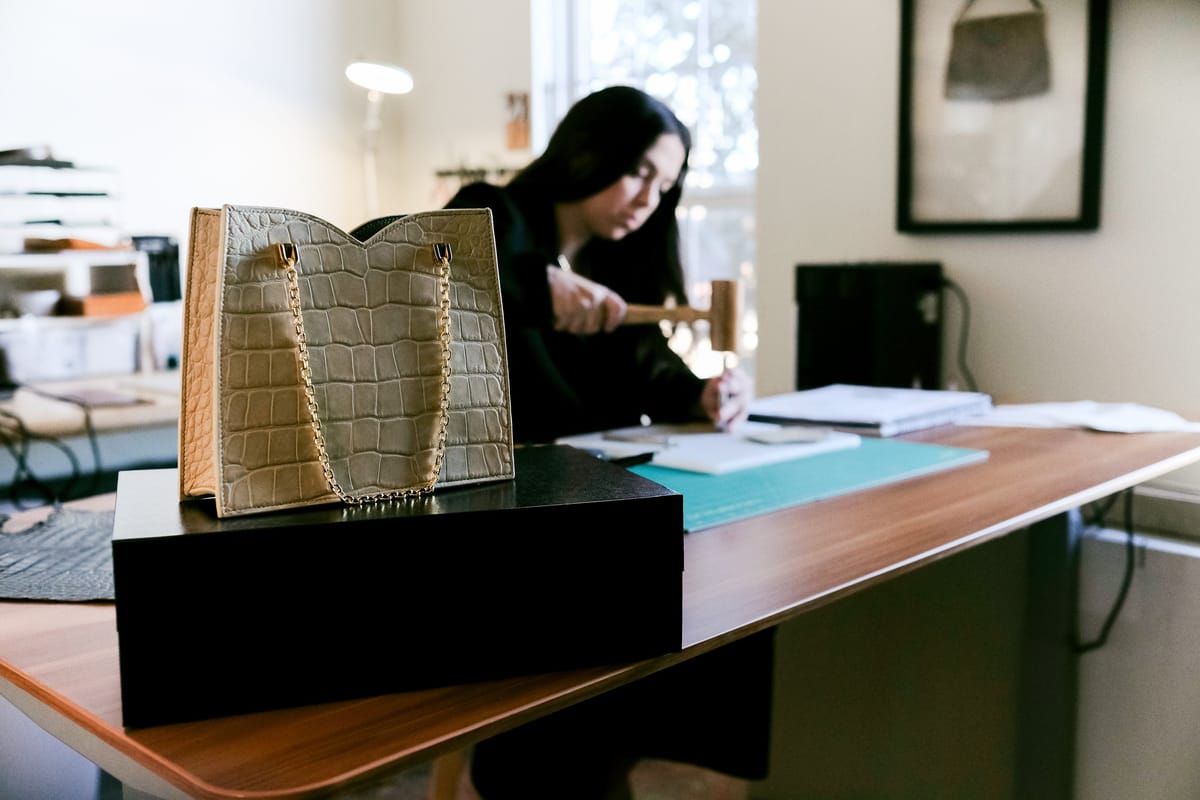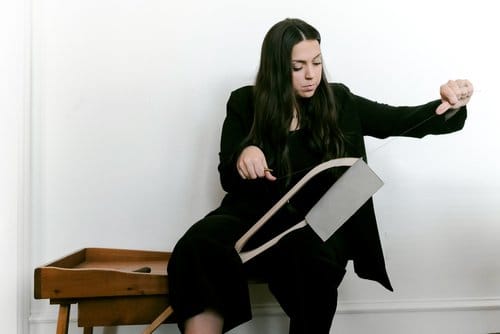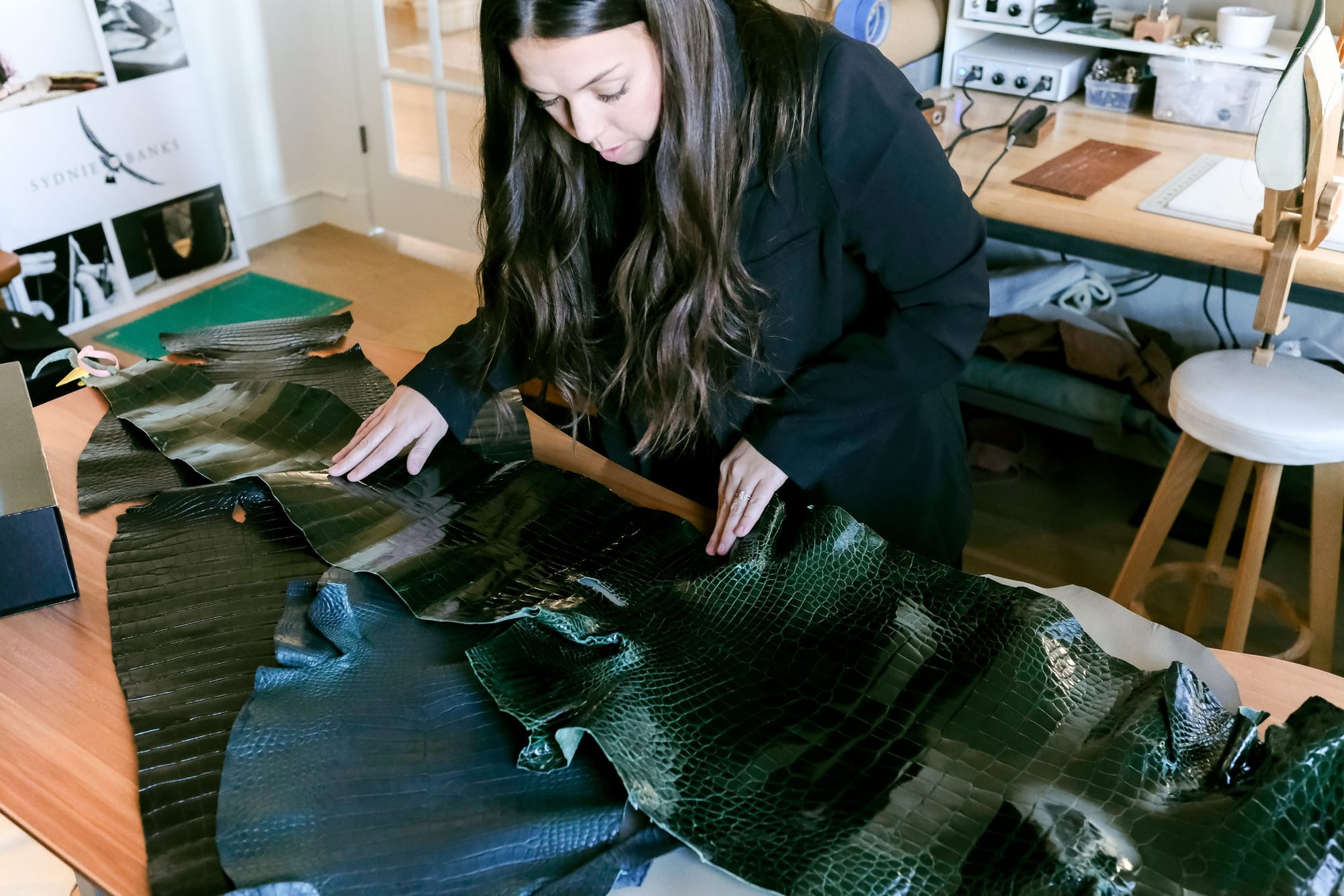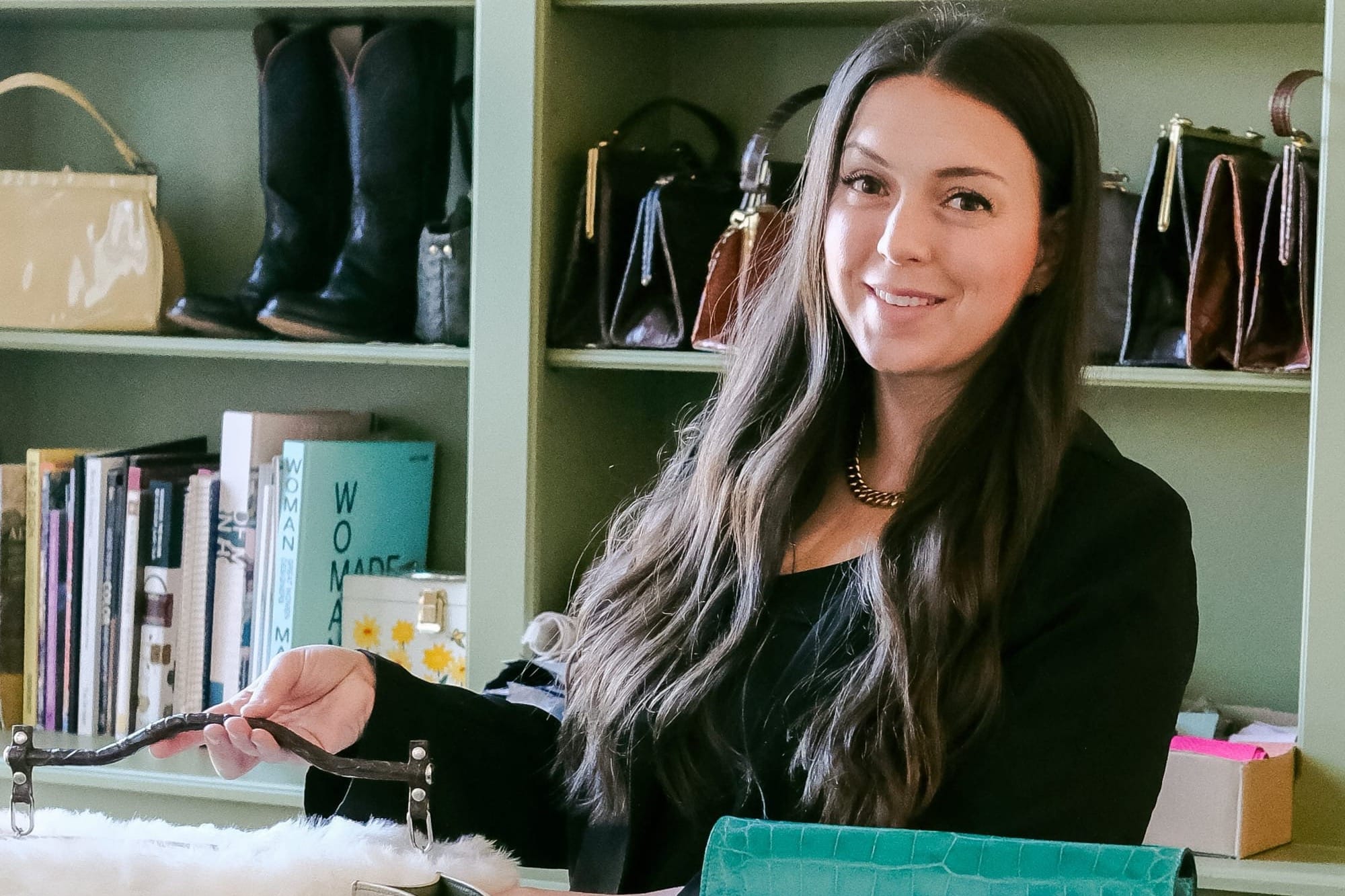
Sydnie Peebles says she always felt “out of place at school” due to the excessive focus on rote learning. As a self-identified tactile learner, she was honest with herself about going to college just to check a box. All her lack of direction changed after watching one serendipitous YouTube video.
“I was watching a video of Marcel Marsan. He’s Hungarian, and he was making and designing men’s dress shoes,” Peebles reminisces. “I watched video after video. It was finally like, ‘Yeah, I want to make shoes — I want to work with leather.’”
When she told her father about her discovery, she experienced yet another moment of serendipity. Peebles’ father knew master cowboy boot maker Lisa Sorrell out of Guthrie, whom Peebles vehemently describes as “being the best in the world at what she does.” How’s that for a lead?
“She’s just the queen. So to train under her was huge as my starting point,” recalls Peebles, who still has a plain five-subject notebook from her 2012 apprenticeship with Sorrell, practically full to the brim with notes and drawings. “She told me, ‘If you can learn to make a cowboy boot, you’ll be able to make anything in leather.’”
Where it happens
Peebles’ home in north Edmond is a large, beautiful and open space. The house is quiet, peaceful. What makes it unique is the presence of a modest but roomy leatherworking studio in the front hall.
Peebles avers that this specific iteration of her leatherworking atelier is temporary and in need of expansion. Despite this, there’s an air of focused discipline here that’s not present in the other living spaces — a notable lack of electronics and other distractions.
Everything is neat and organized just so in the studio. One wall has rolls of creamy and colorful cow leather rolled tight and stored safely in shelves; across from it in separate shelving, piles of ethically sourced American alligator and snakeskins in a rainbow of vibrant colors.
“I try and to the best that I can find. A lot of [my leather] comes from France and some of the best tanneries,” says Peebles. “Just top of the line.”
On the walls are shelves with vintage bags that inspire her — though Peebles’ bags are not on display, but safely tucked in their boxes. A prized purse from her grandmother’s collection is framed on the wall. Additionally, pairs of beautiful leather cowboy boots stand on the shelves.
“That’s the first pair of boots I ever made. So I look at them, and I just see all the imperfections,” Peebles says with a laugh. She retrieves a boot and points to the details of what she identifies as inconsistencies in her stitching. To a layperson’s eye, the stitches look neat and nearly undetectable.


Tough Enough
As Peebles explains, bootmaking is exceptionally complex and physically exhausting. After creating the design on the boot tops, either using stitches, appliques or both, the boots are assembled by sewing them to the vamp and counter (the front and back of the boot that covers the foot). Then the most strenuous part: attaching this assembly to the insole through small wooden pegs malleted into the sole by hand.
“My shoulders got big; it’s so manual,” she said with a laugh. “You have to be strong. You have to be tough.”
Peebles excelled alongside men in Sorrell’s apprenticeship. After her time working with Sorrell and changing her major to Integrated Studio Art, Peebles was looking to explore other mediums in addition to boots, such as handbags.
'Every single bag is one of one'
For many leatherworkers, bags that may still be considered “handmade” are usually sewn at least partly on a machine, even if a master crafter controls that machine. Leather pieces are still cut via computer patterns and thinned precisely using pre-programmed settings. Even if the finished bag has been completely hand-stitched and tooled by hand, the patterns are frequently duplicated to minimize the effort of creating multiple handbags by hand.
Not Sydnie Banks handbags.
“I don’t know if there’s anyone else in the world taking the approach that I’m taking. Most people have a few patterns that they have made, or they have like had someone else make, and they make the same bags over and over,” she says. “I don’t know of anyone who’s taking the approach that every single bag is one of one.”
As she never repeats a pattern or design, sometimes it takes trial and error to get her leather to fit the design on paper and in her mind.
Peebles retrieves a large black box off the top shelf of her cabinet of purses. Underneath the tissue wrapping, she unearths a bag: fluffy, white alpaca leather with a slim American alligator handle. After showing the bag, she recalls frustrations with its process, especially as she was trying to incorporate a vintage handle wrapped with the alligator leather. Early on, she almost called it quits on the original design.
“At first, I was like, ‘This is not going to work, I’m so frustrated.’ So I scrapped it,” says Peebles. “Then, after I was completely done with the bag, I decided to readdress the handle. It made the bag. I was so glad that one of [the handles] was good enough [so] I could readdress it and make it something that would fit my original design.”
Her process needs no computerized cutter, no automated electric tools — just mallets, thread, leather, patterns, finishing and skiving tools … and a craftswoman at work. She starts with a design she drafts on paper, creating hand-cut and -drawn patterns. She expertly measures and cuts each piece to her unique designs and specifications.

A Time and Place for Everything
After cutting the pieces based on the pattern, she skives the leather to the proper thickness to make it easier to join at the seams and hand-sews them with a waxed thread of pure linen. She even waxes her thread herself, with the wax itself sourced from her father-in-law’s beehive.
“It takes days sometimes for a single edge to be where it needs to be, where you cannot even tell there’s any leather pieces in between,” explains Peebles. “The ultimate goal is to have it look perfect.”
Peebles created her first bag as early as 2014, but found the process difficult with the lack of fine control a machine afforded. The time had come to decide if it would be right for her to get continuing education specializing in handbags.
After some tough career decisions on where to move the now-expanding family, Peebles and her husband Chris decided she would postpone her handbag training, and she launched a line of leather baby shoes called Bi•jou Browns. Her choice to create these shoes was an opportunity to create a leather good that was not as physically demanding, as she was pregnant at the time.
However, the Peebles’ lives changed suddenly in 2015 upon the loss of their infant son. When the family had the service for their son Banks, she recalled seeing a flock of birds land and take off near his gravesite.
“During the prayers that were said [at his burial], birds were flying over our heads and going crazy, and the second the prayers were done, they would go silent. And then it happened again,” says Peebles. “Once it was done, there were no more birds. But piled around his grave were baby bird feathers. It was just a really spiritual thing for us.”
This vivid image would stay with Sydnie and Chris in ways neither of them would expect.
Becoming Sydnie Banks
Her resolve to try to finish a fully hand-stitched handbag in 2021 led her to look for a mentor to help develop her leather sewing skills. She contacted Charlie Trevor, one of the most renowned leatherworking and saddle-stitching masters in the world, to see if he had an opportunity to train with him directly in the United Kingdom. As Peebles was not interested in sewing on machines, learning saddle-stitching — a hand-stitching technique stronger than machine stitch — was important to her continued development in the leatherworking trade.
No response for months. She had also contacted another master about training and didn’t hear back either. Peebles was demoralized but not undeterred. It felt like another sign when, one fateful day, both Trevor and her other potential leatherworking mentor emailed her back within one hour of each other. Now with the opportunity to choose whom she wanted to study with, she felt even more confident that the choice to pursue saddle stitching was the right one.
Then, Peebles realized she needed an overarching brand with which her bags would be associated. Originally, she thought the brand’s name would simply be her name, Sydnie Peebles. While in the U.K. researching the Peebles family crest during her training, she had another moment where things fell into place.
“The night before, there was a snowstorm. We tried road after road, and there were closures on every single one,” recalls Peebles. “But on one of our ways, there was a barn owl that flew off of a stone fence post right around our car — literally looked me in the face, then flew off.”
This moment with the owl harkened back to her son’s graveside service in 2015 and their spiritual experience with the birds. She knew at that moment that she wouldn’t use her last name for her handbag artistry, but her first son’s name Banks. And instead of the Peebles crest, she would use a barn owl in flight. The choice to call her brand Sydnie Banks felt as natural as breathing.
The owl logo and word mark took close to 100 iterations to get right, but now it’s also proudly displayed in her studio and evidenced on the 1930s vintage hot foil stamping machine that sits on the shelf, just waiting to emblazon every one-of-a-kind bag.

What's Next
As the brand formally launched in 2022, Peebles is taking some time to get her bearings. She has big plans and plenty of inspiration for her brand. First, after training on saddle stitching with Trevor, she sought out mentorship in handbags.
“I trained with Ellen Valentine. She wrote Leatherwork School and does handbags,” says Peebles. “My approach along the way: Train with those who know what they’re doing. Even if you have to pay to do it, it will pay off in the end.”
In the longer term, Peebles wants to do completely custom bag commissions. As she’s dissatisfied with most of the fixtures she sources from third parties, she wants to build a gold forge to smith her own fixtures out of solid gold instead of gold plate. Additionally, she’s planning her new studio outside the home, in a space engineered to withstand the forge’s heat.
Clearly, she doesn’t lack any inspiration or ambition. What she lacks is time. As a full-time mother, she cherishes the moments with her kids and knows this bustling season of life is temporary.
“[I’ll] keep making until then, on the timeframe that I can. And then when I can go in full force, I’ll have a great skill set,” she says with a smile. “And I’ll be ready to be able to have some quality products that are beautiful and unique.”

